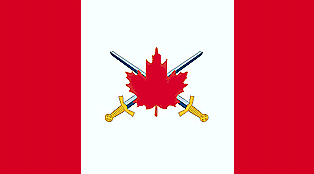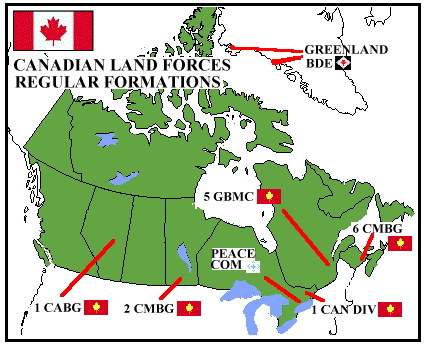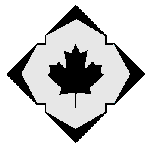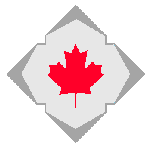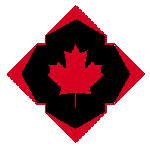Canadian Land Forces: 2300AD Regular Forces
The CEF is a multi-service command controlling all Canadian forces on the French Arm. It is an administrative command as due to the relative size of Canadian forces most of them are placed under the operational control of larger allied units, usually either II (Commonwealth) Corps, 7th or Commonwealth Armoured Divisions. The CEF includes the RCSN Expeditionary Squadron as well as Army and Air assets described in detail in their own sections. The army proportion of this force HQ was provided by the Mobile Command and the Intervention Command. CEF HQ is divided into three sections, Forward, Main and Rear. Forward HQ is a small staff cell located in the Beta Canum system and is currently integrated within the II Corps structure and is responsible for the correct usage of Canadian ground combat units. Main is located on Beowulf and represents the CEF with the Commonwealth Expeditionary Forces HQ in Alicia. Main is a large static HQ and is responsible for strategic operations and logistics of both ground and space forces. Rear is located on Earth and ties the CEF into the Canadian Forces infrastructure. CEF units are noted for their high level of support and transport assets. In fact the CEF has enough starlift assets attached (mostly mobilised civilian craft) to lift all its fighting forces in one lift. This strategic mobility has given the CEF an importance beyond its relatively small size.
Army Mobile Command controls most of Canada's on Earth regular forces. Whilst also being very capable of aiding Canada's defence from any threat they are optimised for deployment outside of mainland Canada. The bulk of AMC forces are composed of the Brigade Groups of the 1st Canadian Division and the independent Anglo-Canadian Brigade that garrisions Greenland.
The 1st Canadian Division is Canada's main regular fighting force. It controls and co-ordinates the operations of the four Brigade Groups deployed under it. It's own forces include an armoured reconnaissance regiment, as well as artillery, air defence, engineering and logistics assets. Currently one brigade is under the command of the Canadian Expeditionary Forces. Canada maintains a policy of integrating reserve personnel into regular formations. These units are donated thus: (*). In the event of mobilisation reservists would be recalled to the colours and fight alongside their regular counterparts. The division is based at CFB Petawawa, Ontario outside the Ottawa-Hull metroplex.
1 Canadian Armoured Brigade Group (att. CEF) Normally based at CFB Edmonton in Alberta 1 CABG is the heaviest combat force in the Canadian Army, it is equipped with the most modern array of equipment available. 1 CABG has been the centrepiece of the Canadian war effort on the French Arm, and has received the highest priority for equipment, support and manpower. Its internal equipment scales were modified to make it more portable by attached starlift assets, however on Beta Canum it has obtained a large number of extra soft-skinned vehicles to make up these deficiencies. The brigade has one armoured regiment equipped with the modern British Montgomery hovertank and the two infantry battalions are equipped with the British designed Kodiak AFV. In addition a regiment of gunships support the brigade group. The brigade is noticeable for its heavy engineer and air defence complement, both proved useful against the Kafers. The close air defence units with their rapid fire plasma canons were very deadly in the ground role. The brigade saw noticeable action against veteran Kafer Remnants in the North of the German Continent in the Jurgenburg mountains. The capacity of the few remaining Kafer Deathsleds and their wily commanders to cause serious casualties in close-quarter engagements has meant that anyone suggesting the Kafers are easy meat gets short shrift from the brigade. In this campaign the Canadians worked closely with local irregulars, German and NAL Jägers and acted effectively as a divisional structure. The brigade's battlegroups are now well practised, although personnel rotations have removed some of the more experienced soldiers and leaders.
2 Canadian Mechanised Brigade Group 2 CMBG is a force similar to 1 CABG, except it is more lightly equipped. The armoured regiment has only two squadron of hovertanks and two squadrons of armoured recce vehicles. The infantry units are equipped with the American designed Tecumseh (M24) APC. 3 RCR have returned from their exploits with the Joint Vogelheim Brigade and are currently rebuilding the battalion back to full strength. The brigade is based at CFB Shilo, Manitoba.
5e Groupe-Brigade Mechanise du Canada 5 GBMC is identical to 2 CMBG, except that the brigades units are mostly drawn from Quebec and is based at BFC Valcartier in that province. The brigade also works mainly in French day to day, but on operations utilises English. Units from 5 GBMC are the most frequently used for exchange duties or bilateral exercises with the French.
6 Canadian Mechanised Brigade Group 6 CMBG was formed in the middle years of the last century to increase the security of the Eastern seaboard of Canada in the face of increased tensions with the Scandinavian Union over Greenland. It regularly exercises in both maritime and arctic conditions. It is based at CFB Gagetown, New Brunswick.
Although not an integral part of 1st Canadian Division the Greenland Brigade is administered by Army Mobile Command. The brigade is based around the town of Upernarvik and the large defence facility at Thule. For many years after the end of the Twilight War Greenland was a Canadian protectorate and later its mineral wealth formed the basis for Canada's and Britain's colonisation efforts. Today alongside Britain, Canada still has commitments to the defence of Greenland. As such it supports the Greenland Brigade with two battalions of infantry and providing part of the brigade headquarters. The brigade is highly skilled in arctic operations. Command of the Brigade is rotated between a Canadian and British Brigadier every two years.
Canada is a major contributor to peacekeeping operations. In order not to disrupt its front-line brigades Canada formed a Peacekeeping Command to provide manpower for its commitments, located at the International Peace Support Training Centre in Kingston. These formations include a number of infantry units but also command, engineering and logistics elements. Canada often works closely with Australian peacekeepers but tend to take on fewer tasks than their more militaristic southern hemisphere counterparts. Whilst the Peacekeeping Command units are the first units called upon it is common for extra troops to be called in from the Mobile or Intervention Commands especially when an operation is in an early stage. Peacekeeping Command is a relatively glamorous part of the Canadian Forces as they are the most frequently deployed on operational duties. However it has been a long term worry for the Generals that the peacekeeping ethos is infecting other parts of the Army and reducing possible combat effective. The performance of the CEF seems to has laid this concern to rest. Units in this command are organised slightly differently than their war-fighting colleagues, being more modular and with higher levels of support and service support. Infantry battalions are organised either as mechanised or light formations. However after several debacles through the years Canadian units now take almost all their integral heavy weapons in theatre with them, even if they remain in crates. This policy served 3 RCR well on Vogelheim when it was caught up in the Kafer War.
Canada is a nation that prefers to rely on the powers of negotiation rather than military force to resolve international disputes. However it retains a small rapid reaction force to deal with the more intractable problems. Elements of the Intervention Command HQ has been used as part of the CEF, and the remaining units have been controlled by a skeleton chain of command. The command includes marine and airborne units, the latter are in transit back from the French Arm.
Although not strictly a part of Canadian Land Forces Colonial Command will be covered in this section. Colonial Command is a small organisation responsible for helping to secure Canada's colonies. The Command's main units are the Special Service Force's Colonial Commandos (No.4 and No.5), but can be reinforced by elements of Mobile or Intervention Commands. The Colonial Commandos are strictly for off-Earth operations. The Colonial Commandos were formed originally as a small force of volunteers available to defend Canadian spaceships and be deployed on the small number of Canadian warships. As Canada's interstellar interests grew along the Chinese Arm, the Colonial Commandos were trained to operate in Canada's colonies and outposts, and was formed into a larger unit formalised as 4 Commando. Like the other SSF units was drawn from volunteers from the various regular units of the Canadian Land Forces. The outbreak of the Slaver War against the Sung in the early 2250's saw the Colonial Commando mustered for operations from its dispersed stations, and it was reinforced by the Canadian Airborne Regiment from Earth. Both units saw action on the Xiang homeworld against Sung installations, and later would man outposts on the Sung homeworld after the armistice. Once the CAR moved back to Earth it was realised that the Colonial Commando was severely overstretched, especially given their new garrison duties on Stark. Consequently another Commando, No.5, was raised and trained to supplement No.4 on the Chinese Arm. Both units are battalion sized Commandos, one of which is normally stationed on the Sung homeworld, and one on Achilles in DM+20 5046. The Colonial Commandos also have a number of Fleet Parties that can be deployed on RCSN ships. They are all highly trained and undergo the Canadian Commando Course, which was originally derived from the British Royal Marines 'Red' Commando Course. The influence of these excellently trained soldiers in the sometimes chaotic Chinese Arm is well in excess of what their small numbers might suggest. Should they require reinforcement, troops from the Intervention Force are on standby. However due to travel times these reinforcements often arrive long after an incident occurs, and reinforcement more often comes from other nations forces in the operational areas. This is usually secured through informal links between commanders and colonial administrators. A composite unit drawn from both Colonial Commandos is embarked on the RCSN's Expeditionary Squadron as part of the CEF. However the bulk of both Commandos has remained on the Chinese Arm where the Canadian forces have taken over most of the duties fulfilled by British ships now deployed elsewhere.
Canadian Division's war fighting system is very similar to that of the British Army. The infantry battalions and armour regiment of the brigade form Battle Groups that swap company and squadron groups between them to form combined arms groups. These groups are designed to have the correct force mix for taking on specific objectives. Canadian armoured regiments normally have four 'sabre' squadrons and a HQ squadron. The 8th Canadian Hussars have one squadron of Makwa CHT-3 Hovertanks, and three squadrons of armoured recce vehicles. The 12e Regiment Blinde du Canada and the Royal Canadian Dragoons each have two Makwa squadrons and two recce squadrons. Lord Strathcona's Horse has three squadrons of Montgomery and one recce squadron. Canadian mechanised infantry battalions are equipped with the ageing Tecumseh (based on the M24), but the units of 1 CABG have recently received the modern British Templer AFV (to be called the Kodiak in Canadian service). Canadian battalions generally have three rifle companies, a HQ company and a fire support company. Although the support company often operates as an extra rifle company when on peacekeeping duties. Peacekeeping doctrine is based around conciliation and the innate professionalism of the Canadian soldier. It often falls on the Canadians to take over the running of whole operations when contingents of soldiers from other nations fail to conduct themselves properly. It is an often thankless task, but one the Canadian public and army alike are proud to take on. The lead agency for security in Canada's New Champlain colony is the Royal Canadian Mounted Police. However they can call on back up from the Colonial Commandos in the case of an emergency. Security at Canada's outposts and it's enclave on Stark is the responsibility of the Commandos. Canada is in the fortunate position of being without any major international rivals. The military is at the centre of a web of bilateral and multi-lateral co-operation agreements with a variety of states. As a result the country is home to a variety of training organisations primarily thanks to the low population density that creates excellent training areas with plenty of elbow room. The mostly notable of these is the Joint Commonwealth Battle School near Medicine Hat in Alberta. This state of the art facility has built on a long history of training manoeuvre warfare units. Currently it is run by a joint Anglo-Canadian staff and provides room for up to three battalions to train simultaneously in real time. A two week deployment to JCBS is the culmination of most training cycles and is a vital part of maintaining battle readiness. Whilst Canadian and British units are the most frequent users other nationalities also make use of the facilities. JCBS OPFOR is provided by a unit of the Royal German Legion. Canada also works closely with the Manchurians as a result of their combined interests on the Chinese Arm, and Canada is one of the few nations to hold bilateral exercises with that nation. Links with France used to be quite strong, however Canadian neutrality in the Central Asian War has caused something of rift to appear. Links with America are strong, but somewhat formal after years of relative American isolationism however joint defence exercises are a frequent occurrence. Canada is also heavily involved in joint training exercises with other Commonwealth of Nations militaries. In particular it runs courses for foreign units and officers at the International Peace Support Training Centre. These courses are often heavily subsidised by the Canadians in an effort to improve the quality of the contingents they might be undertaking peacekeeping duties alongside. |
